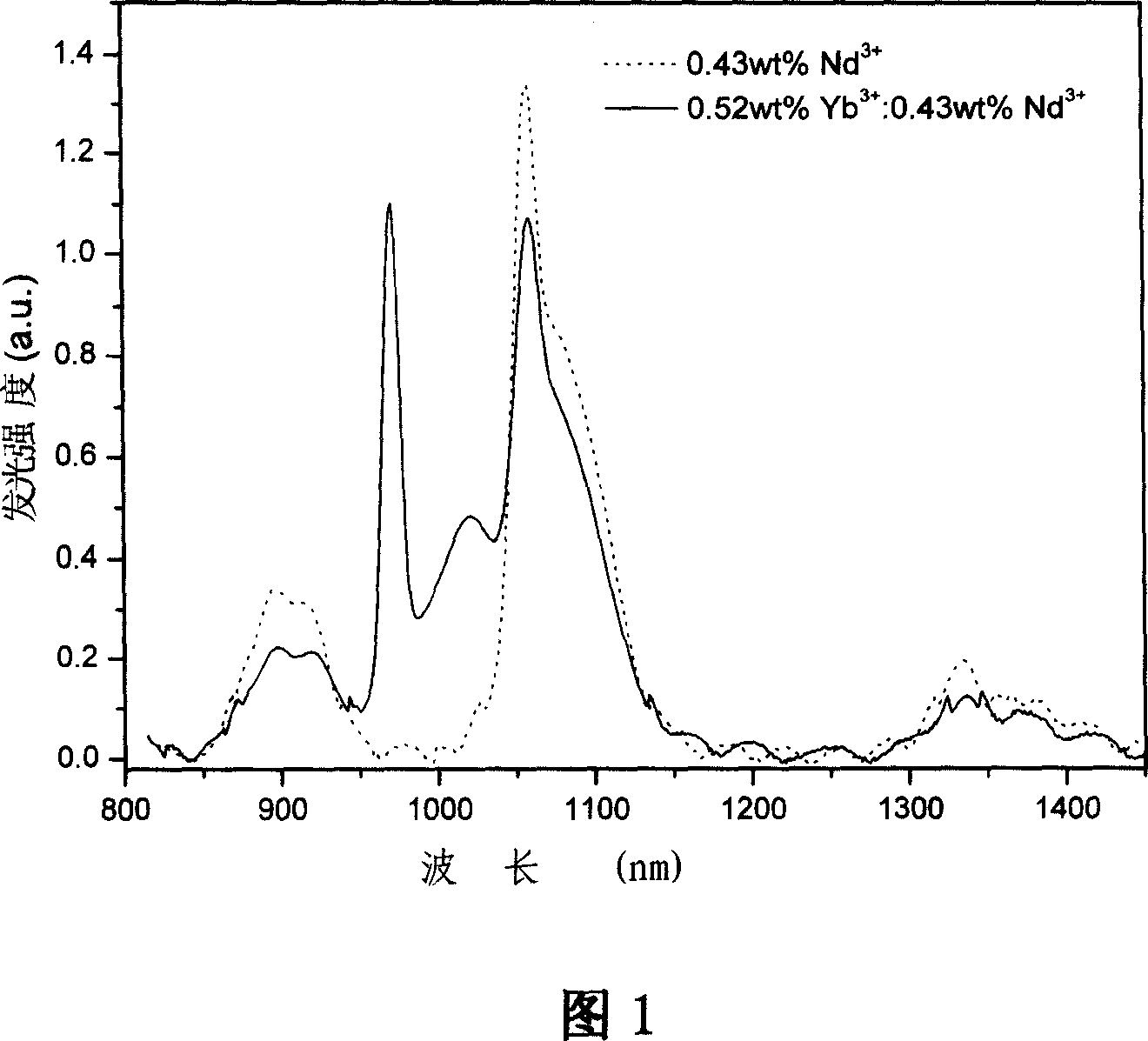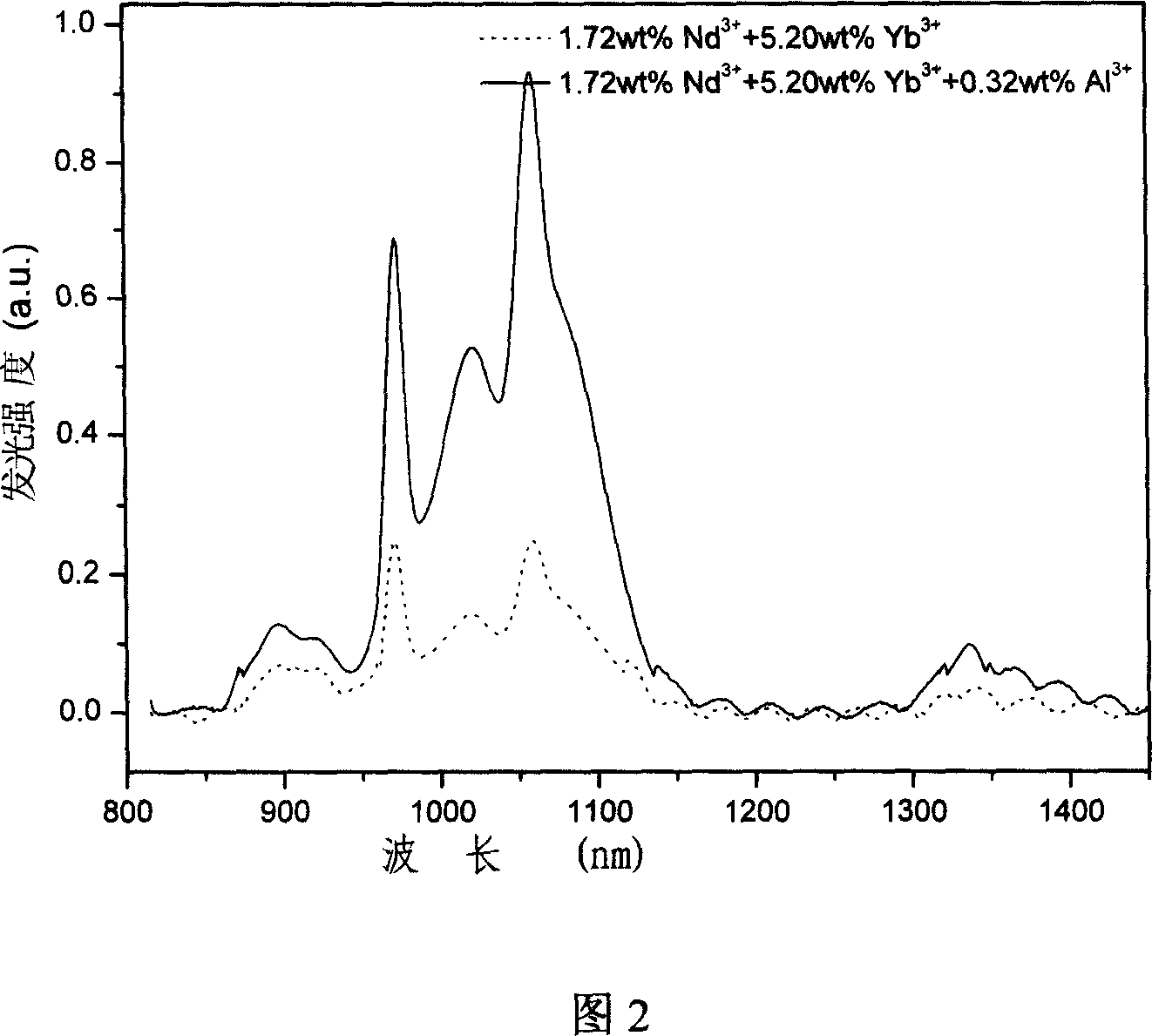Method for producing neodymium-ytterbium co-blended high silicon-oxygen laser glass
A technology of laser glass and its manufacturing method, which is applied in the field of manufacturing Nd-Yb co-doped high-silica laser glass, which can solve the problems of low absorption, failure to significantly enhance luminous intensity, and concentration quenching, and achieve enhanced luminous intensity and suppression of rare earth The effect of spontaneous clustering of ions
- Summary
- Abstract
- Description
- Claims
- Application Information
AI Technical Summary
Problems solved by technology
Method used
Image
Examples
Embodiment 1
[0028] 0.88g of analytically pure Nd(NO 3 ) 3 ·6H 2 O and 0.94g analytically pure Yb (NO 3 ) 3 ·6H 2 O is completely dissolved in deionized water to make 20ml of 0.1mol / L Nd 3+ and 0.1mol / L Yb 3+ A mixed solution of ions. Then the size is 5×5×3mm, SiO 2 The porous glass with a content of more than 94wt% is immersed in the mixed solution for 30 minutes; after the porous glass is taken out of the solution, it is fully dried in the air at 200°C. Afterwards, the porous glass containing neodymium and ytterbium ions is placed in a high-temperature furnace, and undergoes solid-state sintering at 1100°C in an air or oxygen atmosphere to eliminate micropores and become dense and transparent neodymium-ytterbium co-doped high-silica glass. During the sintering process, the temperature rises from room temperature to 900°C at a rate of 10°C / min, then from 900 to 1100°C at a rate of 5°C / min, and is kept at 1100°C for 45 minutes, and then the glass is cooled to room temperature with ...
Embodiment 2
[0030] 8.75g of analytically pure Nd(NO 3 ) 3 ·6H 2 O and 2.82g analytically pure Yb (NO 3 ) 3 ·6H 2 O is completely dissolved in 1mol / L dilute nitric acid to prepare 20ml of 1mol / L Nd 3+ and 0.3mol / L Yb 3+ A mixed solution of ions. Then the size is 5×5×3mm, SiO 2 The porous glass with a content of more than 94wt% is immersed in the mixed solution for 45 minutes; after the porous glass is taken out of the solution, it is fully dried in the air at 300°C. After that, the porous glass containing neodymium and ytterbium ions is placed in a high-temperature furnace, and undergoes solid-state sintering at 1150°C in an air or oxygen atmosphere to eliminate micropores and become dense and transparent neodymium-ytterbium co-doped high-silica glass. During the sintering process, the temperature rises from room temperature to 900°C at a rate of 10°C / min, and then from 900 to 1150°C at a rate of 5°C / min, and is kept at 1150°C for 30 minutes, and then the glass is cooled to room te...
Embodiment 3
[0032] 0.88g of analytically pure Nd(NO 3 ) 3 ·6H 2 O and 9.40g analytically pure Yb (NO 3 ) 3 ·6H 2 O is completely dissolved in deionized water to make 20ml of 0.1mol / L Nd 3+ and 1mol / L Yb 3+ A mixed solution of ions. Then the size is 5×5×3mm, SiO 2The porous glass with a content of more than 94wt% is immersed in the mixed solution for 30 minutes; after the porous glass is taken out of the solution, it is fully dried in the air at 400°C. Afterwards, the porous glass containing neodymium and ytterbium ions is placed in a high-temperature furnace, and undergoes solid-state sintering at 1200°C in an air or oxygen atmosphere to eliminate micropores and become dense and transparent neodymium-ytterbium co-doped high-silica glass. During the sintering process, the temperature rises from room temperature to 900°C at a rate of 10°C / min, and then from 900 to 1200°C at a rate of 5°C / min, and is kept at 1200°C for 50 minutes, and then the glass is cooled to room temperature with...
PUM
 Login to View More
Login to View More Abstract
Description
Claims
Application Information
 Login to View More
Login to View More - R&D
- Intellectual Property
- Life Sciences
- Materials
- Tech Scout
- Unparalleled Data Quality
- Higher Quality Content
- 60% Fewer Hallucinations
Browse by: Latest US Patents, China's latest patents, Technical Efficacy Thesaurus, Application Domain, Technology Topic, Popular Technical Reports.
© 2025 PatSnap. All rights reserved.Legal|Privacy policy|Modern Slavery Act Transparency Statement|Sitemap|About US| Contact US: help@patsnap.com


